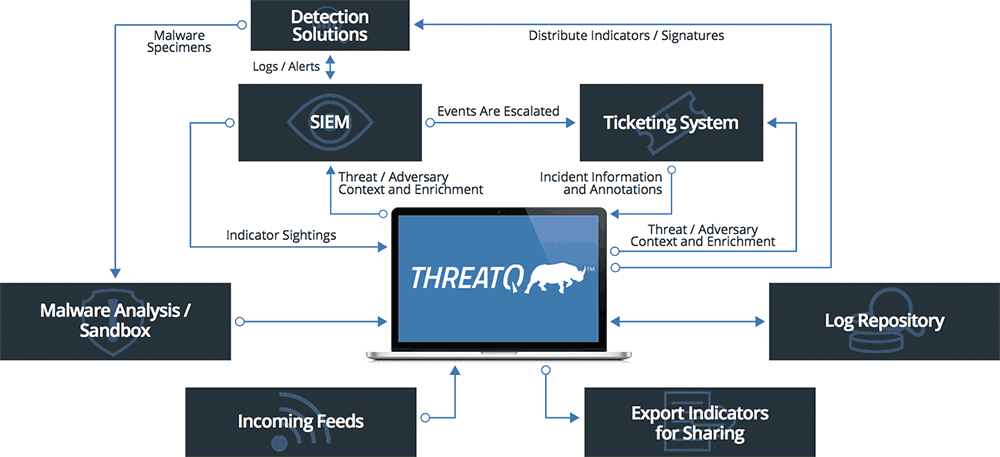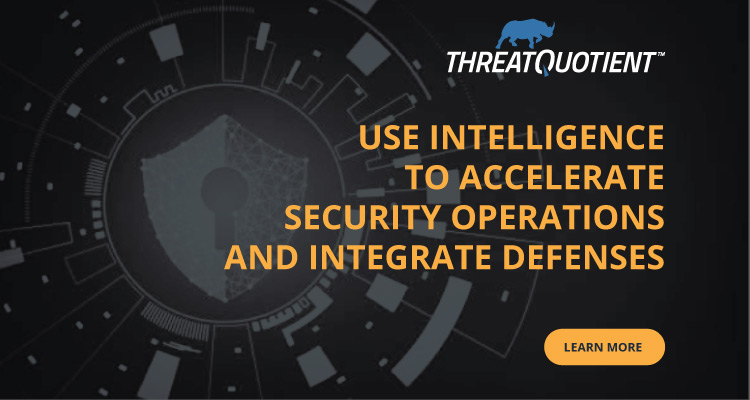What is ThreatQuotient?

ThreatQuotient is a threat intelligence platform designed to help organizations manage and operationalize threat intelligence effectively. It provides a range of capabilities for collecting, analyzing, and acting upon threat intelligence data to enhance cybersecurity.
ThreatQuotient’s flexibility and extensive capabilities make it a valuable tool for organizations aiming to improve their overall cybersecurity posture and respond effectively to cyber threats and incidents. The platform’s features may evolve over time to address emerging threats and challenges in the cybersecurity landscape.
Top 10 use cases of ThreatQuotient:
Here are the top 10 use cases of ThreatQuotient:
- Threat Intelligence Aggregation: ThreatQuotient aggregates threat intelligence data from multiple sources, including open-source feeds, commercial providers, and internal sources, to provide a comprehensive view of the threat landscape.
- Incident Response: The platform assists organizations in responding to security incidents by providing contextual information about threats, indicators of compromise (IOCs), and suggested response actions. This accelerates incident investigation and resolution.
- Vulnerability Management Integration: ThreatQuotient integrates threat intelligence into vulnerability management processes, helping organizations identify and prioritize vulnerabilities actively being exploited or targeted by threat actors.
- Security Operations Center (SOC) Enhancement: It enhances the capabilities of security operations centers by providing threat intelligence data that can be used to identify and respond to threats more effectively.
- Phishing Detection and Mitigation: ThreatQuotient aids in the detection and mitigation of phishing attacks by identifying phishing-related indicators and providing real-time alerts about phishing campaigns.
- Threat Hunting: Security teams can proactively hunt for threats within their network by leveraging threat intelligence data to search for anomalous or suspicious activity.
- Security Orchestration and Automation: ThreatQuotient supports security orchestration and automation efforts by providing tools for automating security workflows and response actions based on threat intelligence.
- Custom Threat Feeds: Organizations can create custom threat intelligence feeds tailored to their specific needs and infrastructure. ThreatQuotient allows users to manage and share these custom feeds.
- Dark Web Monitoring: It monitors activity on the dark web and underground forums to identify emerging threats and cybercriminal activity.
- Collaboration and Information Sharing: ThreatQuotient facilitates collaboration among security teams and enables information sharing with trusted partners and industry peers.
- Threat Intelligence Reporting: The platform offers reporting and visualization capabilities to help organizations understand and communicate threat insights effectively. It allows for the generation of reports and dashboards.
- Security Awareness Training: ThreatQuotient’s threat intelligence data can be used for security awareness and training programs to educate employees about potential risks and threats.
What are the feature of ThreatQuotient?
ThreatQuotient is a threat intelligence platform with a range of features designed to help organizations effectively manage, analyze, and operationalize threat intelligence data. While the specifics of its features and capabilities may evolve with updates and new versions, here are some of the key features typically associated with ThreatQuotient:
Key Features of ThreatQuotient:
- Threat Intelligence Aggregation: ThreatQuotient collects and aggregates threat intelligence data from various sources, including open-source feeds, commercial providers, and internal sources.
- Normalization and Enrichment: The platform normalizes and enriches threat intelligence data, ensuring that it’s in a consistent format and adding contextual information to provide deeper insights.
- Incident Response Support: ThreatQuotient offers support for incident response efforts by providing contextual information about threats, indicators of compromise (IOCs), and suggested response actions. This accelerates incident investigation and resolution.
- Vulnerability Management Integration: ThreatQuotient integrates threat intelligence into vulnerability management processes, helping organizations identify and prioritize vulnerabilities actively being exploited or targeted by threat actors.
- Real-time Threat Detection and Analysis: Security teams can use ThreatQuotient to detect and analyze threats by correlating incoming threat intelligence data with their network and endpoint data. It helps in identifying and responding to potential threats quickly.
- Phishing Detection and Mitigation: The platform aids in the detection and mitigation of phishing attacks by identifying phishing-related indicators and providing real-time alerts about phishing campaigns.
- Threat Hunting: Security teams can proactively hunt for threats within their network by leveraging threat intelligence data to search for anomalous or suspicious activity.
- Security Orchestration and Automation: ThreatQuotient supports security orchestration and automation efforts by providing tools for automating security workflows and response actions based on threat intelligence.
- Custom Threat Feeds: Organizations can create custom threat intelligence feeds tailored to their specific needs and infrastructure. ThreatQuotient allows users to manage and share these custom feeds.
- Dark Web Monitoring: It monitors activity on the dark web and underground forums to identify emerging threats and cybercriminal activity.
- Collaboration and Information Sharing: ThreatQuotient facilitates collaboration among security teams and enables information sharing with trusted partners and industry peers.
How ThreatQuotient works and Architecture?

ThreatQuotient’s architecture and functionality can be summarized in the following steps:
- Data Collection: ThreatQuotient collects threat intelligence data from various sources, including open-source feeds, commercial providers, and internal sources.
- Normalization and Enrichment: The collected data is normalized to ensure consistency and enriched with contextual information, such as threat actor profiles, tactics, techniques, procedures (TTPs), and associated indicators.
- Data Storage and Management: Threat intelligence data is stored in a centralized repository that is accessible for analysis. The platform allows users to manage and organize threat intelligence feeds and data.
- Correlation and Analysis: ThreatQuotient employs analytics and correlation capabilities to identify patterns, trends, and correlations within the data. It helps in identifying potential threats and vulnerabilities.
- Alerting and Reporting: The platform generates alerts and notifications based on predefined criteria or custom configurations. It also offers reporting and visualization capabilities to help organizations understand and communicate threat insights effectively.
- Integration: ThreatQuotient can be integrated with other security solutions, such as SIEM, SOAR, and endpoint security tools, to enhance threat detection and response capabilities with threat intelligence.
- Customization: Organizations can customize and tailor ThreatQuotient to meet their specific needs, including the creation of custom threat feeds and workflows.
- Collaboration: ThreatQuotient fosters collaboration and information sharing among security teams, helping them work together to defend against cyber threats effectively.
ThreatQuotient’s architecture is designed to facilitate the collection, analysis, and dissemination of threat intelligence data, enabling organizations to make informed decisions and enhance their cybersecurity defenses. The platform’s features may evolve to address emerging threats and challenges in the cybersecurity landscape.
How to Install ThreatQuotient?
To install ThreatQuotient, you will need the following:
- A virtual machine with of storage at least 8 GB of RAM and 100 GB
- A Linux operating system, such as CentOS or Ubuntu
- A Python 3.6+ environment
- A PostgreSQL 11+ database
Once you have the necessary prerequisites, you can follow these steps to install ThreatQuotient:
- Download the ThreatQuotient installation package from the ThreatQuotient website.
- Extract the installation package to a directory on your virtual machine.
- Open a terminal window and navigate to the directory where you extracted the installation package.
- Run the following command to start the ThreatQuotient installation process:
sudo bash install.shCode language: CSS (css)- Apply the on-screen instructions to fulfill the installation process.
Once the installation process is complete, you can access the ThreatQuotient web UI at the following URL:
https://<your_virtual_machine_IP_address>:9060Code language: HTML, XML (xml)The default username and password for the ThreatQuotient web UI are admin and password.
Some additional tips for installing ThreatQuotient:
- If you are using a cloud-based virtual machine platform, such as AWS or Azure, you will need to create a security group or network security group to allow access to the ThreatQuotient web UI.
- If you are installing ThreatQuotient in a production environment, it is recommended to follow the ThreatQuotient hardening guide to secure your installation.
- You can also find a variety of tutorials and other resources on the ThreatQuotient website.
ThreatQuotient is a powerful security intelligence platform that can help you to improve your security posture by helping you to identify, assess, and mitigate threats to your organization. By following the steps above, you can learn how to install ThreatQuotient and start using it to improve your security posture.
Basic Tutorials of ThreatQuotient: Getting Started

The following steps are the basic tutorial on how to use ThreatQuotient to improve your security posture:
- Getting Started
- Create a ThreatQuotient account.
- Log in to the ThreatQuotient web UI.
- Review the Getting Started documentation.
- Adding Data
- Add your security data to ThreatQuotient.
- ThreatQuotient can import data from a variety of sources, including SIEMs, firewalls, and security tools.
- Creating Incidents
- Create incidents in ThreatQuotient when you detect suspicious activity.
- Incidents can be created manually or automatically based on events in your security data.
- Investigating Incidents
- Investigate incidents in ThreatQuotient to identify the root cause of the incident and to determine the best course of action.
- ThreatQuotient provides a variety of features to help you investigate incidents, such as threat intelligence, analytics, and collaboration tools.
- Responding to Incidents
- Respond to incidents in ThreatQuotient to contain the damage and to prevent the incident from happening again.
- ThreatQuotient provides a variety of features to help you respond to incidents, such as automated playbooks and case management tools.
- Reporting
- Generate reports in ThreatQuotient to track your security posture and to identify trends in your security data.
- ThreatQuotient provides a variety of reports, including incident reports, threat intelligence reports, and compliance reports.
Some additional tips for using ThreatQuotient:
- Use the ThreatQuotient community to get help and support from other ThreatQuotient users.
- Take advantage of ThreatQuotient’s training resources to learn more about the platform and how to use it effectively.
- Contact ThreatQuotient support if you have any questions or problems.
ThreatQuotient is a powerful security intelligence platform that can help you to improve your security posture by helping you to identify, assess, and mitigate threats to your organization. By following the steps above, you can learn how to use ThreatQuotient to collect, investigate, respond to, and report on security incidents.

👤 About the Author
Ashwani is passionate about DevOps, DevSecOps, SRE, MLOps, and AiOps, with a strong drive to simplify and scale modern IT operations. Through continuous learning and sharing, Ashwani helps organizations and engineers adopt best practices for automation, security, reliability, and AI-driven operations.
🌐 Connect & Follow:
- Website: WizBrand.com
- Facebook: facebook.com/DevOpsSchool
- X (Twitter): x.com/DevOpsSchools
- LinkedIn: linkedin.com/company/devopsschool
- YouTube: youtube.com/@TheDevOpsSchool
- Instagram: instagram.com/devopsschool
- Quora: devopsschool.quora.com
- Email– contact@devopsschool.com

